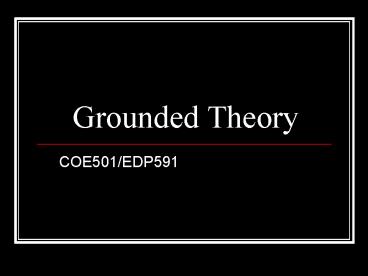Grounded Theory - PowerPoint PPT Presentation
1 / 12
Title:
Grounded Theory
Description:
Introduced by medical anthropologists Barney Glaser & Anselm Strauss. Emerged in the 1960's from the University of Chicago school of sociology ... – PowerPoint PPT presentation
Number of Views:1904
Avg rating:5.0/5.0
Title: Grounded Theory
1
Grounded Theory
- COE501/EDP591
2
Grounded TheoryQuantitative-Qualitative
Transition
- Introduced by medical anthropologists Barney
Glaser Anselm Strauss - Emerged in the 1960s from the University of
Chicago school of sociology - Tied to Deweys pragmatism of identifying meaning
through function and context - Stressed field-work over statistical analysis
allowing data to create theory emphasizing
active participation in social issues of the day - Nevertheless, strongly postpositivist and
theory-building
3
Principles of Grounded Theory
- Trust in emergence
- The quality of a theory is determined by how it
is constructed - Iterative testing of theories follows tenets of
postpositivism, making theories both exploratory
and confirmatory - Theories are highly structured and hierarchical
4
How to Do It Step 1
- Study should begin as theory-free as possible
the situation is of interest, not a question or
problem - Collect rich descriptions of people, places,
interactions, events, without looking for a
particular pattern or making judgments - Data should support triangulation collect
interviews, observations, existing documents,
etc. - Field notes and other forms of objective
recording are used observations allowed to flow
freely
5
How-to Step 2
- Data is examined for emergent patterns begins
with open coding, ad hoc codes without a
framework - People, objects, events are examined from the
perspective of their function in the environment,
their interactions
6
How-to Step 2 continued
- Coding involves line-by-line reading
- Why is this happening? What purpose does it serve
in this environment? - How would things be different if this
person/object/event were absent? - Constant comparison helps to reveal role, and
therefore meaning - In time, patterns emerge in coding
7
How-to Step 3
- Memos capture theoretical speculations about
patterns and their meaning - Memos also used to reflect on the role of the
researcher must affect the ecology, so must take
this into consideration - Memos should be reviewed frequently, and new
memos added as spinoffs
8
How-to Step 4
- The interaction of memoing and coding gradually
leads to standardization of codes - Axial coding codes placed into hierarchical
categories
9
How-to Step 5
- As coding becomes more structured and formal,
goal turns toward theory testing - Different data types and sources should
converge - Purposive sampling of key situations that could
support or discredit the theory - Search for disconfirming cases to try to break
the theory
10
How-to Step 6
- Final framework of codes is honed to the core
category, the portion of the hierarchy with the
greatest explanatory power - This is the theory that would be reported as the
results of the study
11
Uses of Grounded Theory
- Exploration of an ecology
- Development of a theory that could guide
prediction, intervention, explanation - Systematic analysis of qualitative data
- Codification of patterns and ideas
12
What Grounded Theory is Not For
- Testing of an existing theory
- Addressing a specific question or problem
- Generalizing beyond a particular sort of
situation, interaction - Examination of qualitative data without imposing
a particular framework








![[PDF⚡READ❤ONLINE] Grounding Grounded Theory: Guidelines for Qualitative Inquiry PowerPoint PPT Presentation](https://s3.amazonaws.com/images.powershow.com/10046641.th0.jpg?_=202406030410)

![[PDF⚡READ❤ONLINE] Sexuality Counseling: Theory, Research, and Practice (Counseling and PowerPoint PPT Presentation](https://s3.amazonaws.com/images.powershow.com/10046716.th0.jpg?_=202406030511)




















